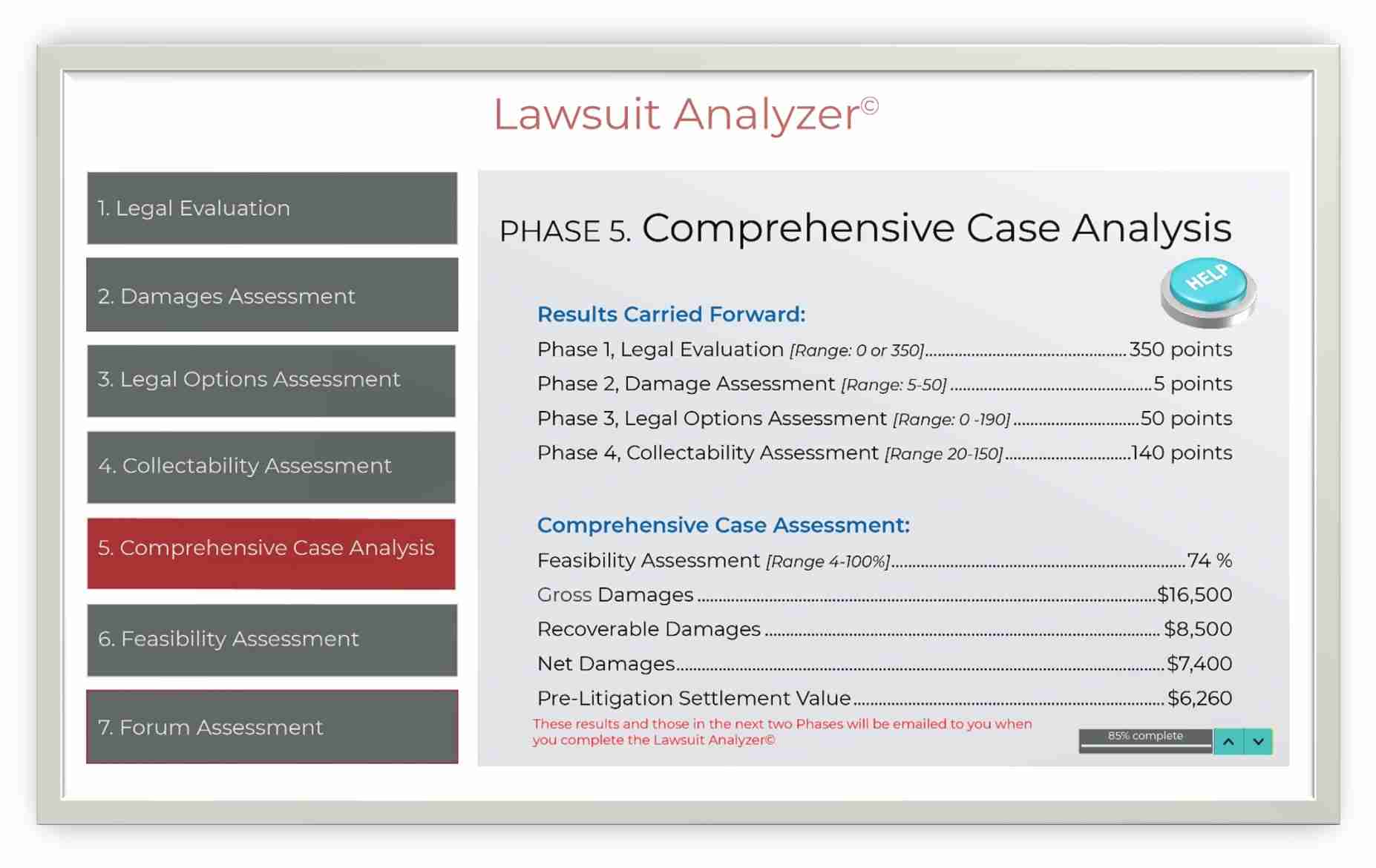Phase 5: Comprehensive Case Analysis
Phase 5 brings all your hard work together in a multi-faceted assessment process! An algorithm is applied to the results of the prior four phases: Legal Evaluation, Damages Assessment, Legal Options Assessment, and Collectability Assessment. This Phase takes what started as a set of facts and yields a complex damages analysis and two more critical results: Your Case Feasibility Assessment and your Pre-Litigation Settlement Value. Your Damages are also repeated from Phase 2.
- Review the results of each phase, the significance of each, and where they are weak and strong. See if you can improve on your weak scores.
- Recall that you can change previous answers. You also have a second license to Lawsuit Analyzer©. Refer to your printed out Instructions. We don’t have support for you if you fail to follow instructions.
- Review your damages and how they whittled down from Gross to Net as your dispute traveled through the portals of analysis.
- Realize that the longer you stay in an adversarial battle, the more your potential pot dwindles.
We’ve covered damages extensively in Phase 2, so now let’s focus on your Feasibility Assessment and Pre-Litigation Settlement Value.
Feasibility Assessment
Feasibility Assessment answers this question: How likely are you to come out of this feeling relatively good about your projected outcome?
- Your Feasibility Assessment does not meet the standard definition of winning because you can win a case but if you can’t turn your judgment into cash, if you paid an attorney most of what you’ve recovered, or if it took you several stressful years to get to trial, you haven’t really won.
- Lawsuit Analyzer’s Feasibility Assessment considers the important facets of your case – your likelihood of winning, your damages and how they are nibbled away the longer your dispute goes on, contract provisions that enhance feasibility, the shortcomings or advantages of the Forum that will decide your dispute, and your chances of collecting on your judgment. This is what legal feasibility should encompass and why Lawsuit Analyzer© is the first program of its kind to perform such a global assessment.
- The Feasibility Assessment you receive is in the form of a percentage peaking at 100%. Fifty % is considered average with ranking going up and down from there. In Phase 6 your Feasibility Assessment is examined and you will receive detailed guidance as to what your rating means and how best to proceed from here.
Pre-Litigation Settlement Value
Another important assessment of Phase 5 is your Pre-Litigation Settlement Value which is an estimate based on your Recoverable Damages from Phase 2 adjusted by your Feasibility Assessment.
- Pre-Litigation Settlement Value applies at settlement or Mediation before you have filed your case. After you begin a legal battle, it no longer applies as you have likely spent funds on attorneys and case costs.
- Keep in mind that your suggested Pre-Litigation Settlement Value is a target, not your bottom line. Always consider an offer that is below this amount.
- When considering settlement, keep the next step ahead clearly in focus, whether to battle it out in the Upper Civil Courts or Arbitration or even in Small Claims Court.
- A compromising state of mind is essential. Avoiding an expensive and aggravating adversarial battle is worth giving up a few thousand dollars or more to button up a settlement quickly.
- Once you officially begin your case by submitting to the final arbiter, whether it be Arbitration, Small Claims Court, or the Upper Civil Courts, you will need to adjust this settlement figure by the costs you incur and by the prognosis of your case as issues and facts are revealed.
- Bargaining positions shift as your case moves along, and you need to stay tuned in and able to change your position.
When you complete Lawsuit Analyzer©, your results for Phase 5-7 will be emailed to you so you can ponder all values and recommendations over time.
EXAMPLE: THE CASE OF THE CRAFTY COMPUTER CONSULTANT
This is Betty’s Comprehensive Case Analysis:

Betty’s feasibility rating is 74% out of 100% which is reasonably good. She followed her Feasibility Recommendations (which you will also receive in the next phase) and recapped her situation like this:
- Betty sent Crafty a Demand Letter advising that if he didn’t pay up, she had no alternative but to sue him.
- She’s had three discussions with Crafty since then trying to resolve their dispute. Betty feels she has done everything she can to settle without the help of a good mediator.
- She is headed for the complex Upper Civil Courts, and the least expensive attorney she could find to represent her is $350 per hour. If she wins, she’ll get most of what she pays back since her agreement with Crafty includes an Attorney Fee provision, but she will be out of pocket those fees as her case proceeds the slow road to trial. [A couple of attorneys offered to represent her on a 40% contingent fee basis, but she decided the fee was too high. She would rather control time and pay as she goes.]
- She does not have an Alternative Dispute Resolution Agreement with Crafty, so she will now present Crafty with an ADR Agreement first calling for Mediation, and if unsuccessful, Arbitration. The inducement is to make the long and expensive road ahead through the Upper Civil Courts the enemy instead of one another.
- If Crafty does not agree to these alternative procedures, Betty should develop a Plan B which in her case would be to again consider reducing her claim to an amount within the Small Claims Court limit so she can get this over quickly.
- Crafty gets back to Betty and advises that he doesn’t want to go to ADR. If she wants to take him on a long journey through the Upper Civil Courts, he’s up for it. Betty then decides to seriously consider Small Claims Court as her Plan B.
Betty uses the second link to Lawsuit Analyzer© to test out Plan B, reducing her claim to the Small Claims limit. [Remember, you have a second link, so you too can develop a Plan B if called for. Don’t open the second link when you have this program open; it will cause havoc.]
PLAN B
As you can see below, Betty’s results improved significantly because the quick and easy Small Claims Court will be her Forum.

- Her Damages Assessment increased from 5 to 50. Her Legal Options Assessment has more than tripled from 50 to 175. Her Feasibility Assessment has increased from 74% to 97%. The Pre-Litigation Settlement Amount has increased due to these factors and the minimal amount of time and fees she will spend on her case in quick and easy Small Claims Court. [Note, Betty won’t be able to recover this settlement amount if she proceeds with Plan B, but at this Pre-Litigation stage before filing in Small Claims Court she still has a claim for $8,500. Crafty doesn’t know she is contemplating Plan B, and $8,500 is still the liability he may face.]
- This result conveys a profound message about resolving disputes. If you are headed for the Upper Civil Courts, and can’t get your opponent to agree to ADR, reduce your claim if your Recoverable Damages are somewhat close to the Small Claims Court limit.
- Although Betty will not net the $6,400 estimated for her case after spending two or more years in the Upper Civil Courts paying her attorney and spending 25 hours of her own time, in Small Claims Court she should net $4,250 in a couple of months.
- It’s a no-brainer for her, Small Claims Court is her answer. She feels that putting her energy into growing her business is far more productive than a long, involved court battle and the stress that comes with it just to recover a couple of thousand more.
- Betty also understands the court system is far from perfect; anything could happen. She could end up a big loser, losing her case and also paying Crafty’s attorney fees. She doesn’t feel like taking this risk. She will also talk to her accountant and see if she can write off the loss that will result from reducing her claim to the Small Claims Court limit.
- Before deciding in favor of Small Claims Court, she’s going to see if Crafty is willing to meet and take one last stab at settlement. Her recommended Pre-Litigation Settlement target for Plan B is $7,820, so she has a lot of wiggle room between what she may net at Small Claims and the recommended settlement target. [The recommended settlement amount for Plan B is higher than Plan A since the Feasibility Assessment is higher.]
- The reason we gave you two links to Lawsuit Analyzer©is for you to also develop a Plan B. Still shoot for Plan A, as Betty has done here, but have Plan B ready to implement if Plan A isn’t looking good.
- Betty and Crafty did end up settling. Crafty wasn’t interested in more settlement discussion but found automated online negotiation (AON) worth a shot as a last ditch effort to get past their dispute. This was a good choice as they settled for $5,950 on the AON platform.
Phase 6, Feasibility Assessment, is next which examines your feasibility assessment received in Phase 5 with a detailed explanation and recommendations of how to most effectively proceed.
